Raw Milk from Organic Fed Goats For Sale
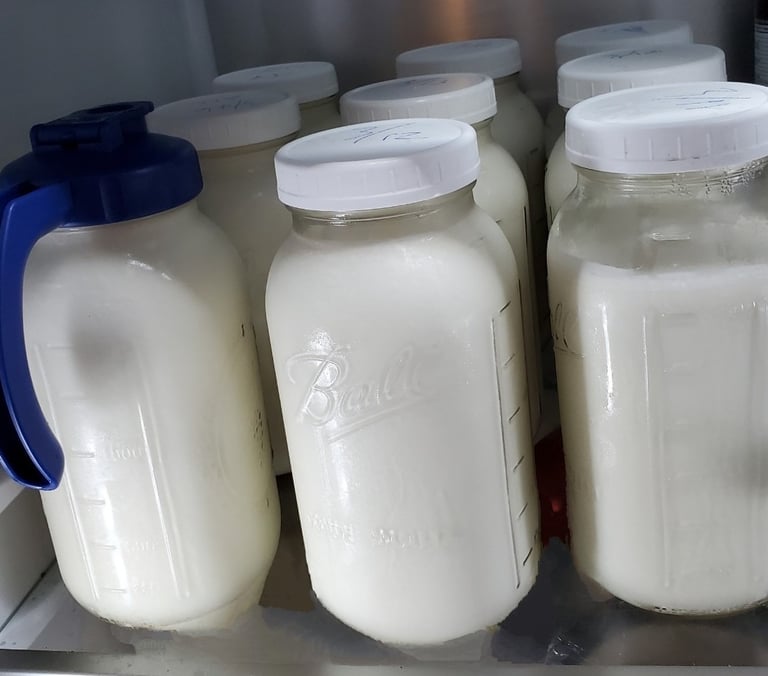

Milk season is over for the year. Planned to start back up in January. This is to allow the milking does a needed break before next season. They individually taper themselves off in the fall at different rates.
Fresh raw goat milk from our organic fed Oberhasli goats. These ladies are doing great work making a bunch of delicious milk. We are marketing as pet quality for now with the intention of upgrading at some point to sell for human consumption. We sell the milk in glass jars with a plastic or metal top. We offer this raw milk during season, typically from Jan/Feb through Oct/Nov. They typically will start to dry themselves off in the fall and they need a break before the next season starts anyways. So, there are a few months where it's not available. It does freeze well, and we used it frozen throughout last year's dry season.
We also offer frozen colostrum from this year's kidding season. It is kept frozen in our deep freezer. 16 oz is usually enough to get one goat kid through the first 24 hrs if following a typical baby goat feeding chart by weight. Colostrum is collected the first 72 hours and frozen as soon as there's enough to do so after feeding our own goat kids. Limited supply and once it's gone we won't have more until next spring.
Ideal as a dietary supplement, tasty treat, or nutritious addition to a balanced diet.
Who Benefits from Raw Goat Milk?
Dogs and Cats: Supports digestion, promotes a shiny coat, and adds hydration to their diet.
Small Animals: A nourishing supplement for rabbits, guinea pigs, and other small pets.
Livestock: Suitable for kids, lambs, and other baby animals in need of supplemental milk.
How to Use
Serving Suggestions:
Small pets: 2 oz per day.
Medium pets (20–40 lbs): 4 oz per day.
Larger pets: Adjust based on weight and dietary needs.
Storage: Keep refrigerated. For longer shelf life, milk can be frozen.
Local farm pickup or farmers market only.
*We last herd tested October 2025 and everyone is clear. See our Herd Health page for more info. Documentation can be provided upon request.
WARNING: NOT FOR HUMAN CONSUMPTION THIS PRODUCT HAS NOT BEEN PASTEURIZED AND MAY CONTAIN HARMFUL BACTERIA

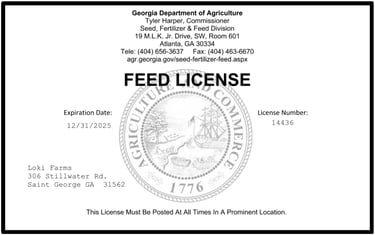
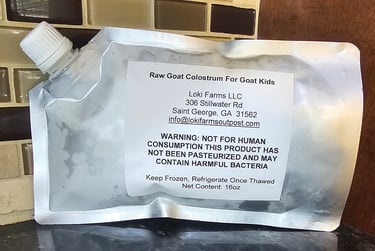

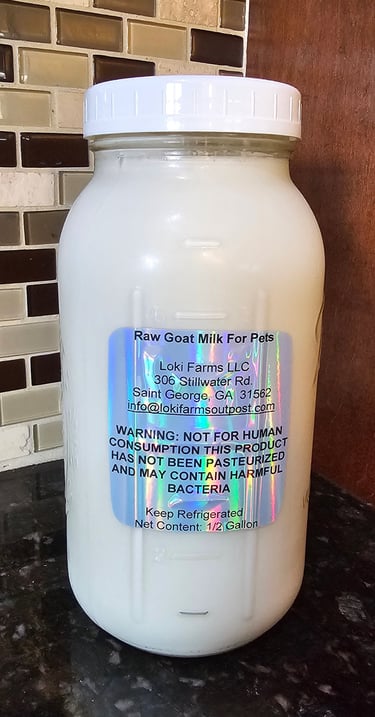

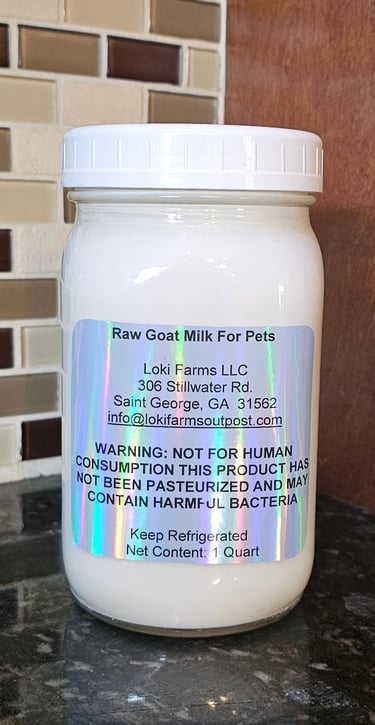

Half gallon raw pet quality goat milk in glass jar.
$10, 2 dollars off when my jar comes back.
Sold out for the season
1 Quart raw pet quality goat milk in glass jar.
$5, 1 dollar off when my jar comes back.
Sold out for the season
Please contact for availability and pick up. We cannot meet in Florida as we don't have a Florida license.
16 oz Frozen Raw goat colostrum in double sided foil pack
$15
From our clean tested herd last tested October 2025. Colostrum collected within first 72 hours only.
Not heat treated.
Coming soon!! 6 oz Frozen Raw goat colostrum in twist top bag. Fits a Pritchard nipple
$6
From our clean tested herd last tested October 2025. Colostrum collected within first 72 hours only.
Not heat treated.
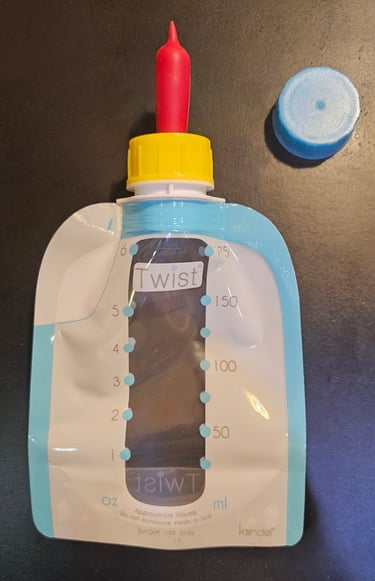

Milk Order Form
Sold out for the season
We will be milk testing for the 2026 season!
2026 will be our first year DHIR milk testing, so it's been an experience figuring out how to go about it and getting started. I intended to start this last year, but we didn't get everything together until halfway through the season. We've got everything now and plan to start next season off strong. On this page, I'll be posting a picture of the results as they come in.
We're doing this for a couple reasons. For one, we have 2 out of our 3 in milk right now that I am pretty sure can get milk stars for the amount they put out. Miss Daisy being number 1, putting out over a gallon a day and Gem number 2, putting out right around a gallon give or take depending on her mood. Altogether we were getting over a gallon twice a day. Coming to the end of the season, everyone tapered off quite a bit.
And the other more important reason for milk testing is we'll be getting an analysis of the milk from each goat each month. It includes, first and foremost, the somatic cell count. If high, it would indicate someone likely has mastitis. In which case we'd pull from selling until tested clear. Also included are butterfat, fatty acids, protein, casein, lactose, total solids, milk urea nitrogen, and freezing point depression. All of which should give us a good idea of the milk quality.
We do not use antibiotics unless absolutely necessary. If we do end up having to use them while a goat is in milk, the milk will be tested clear before being offered up for sale again.
We have switched to organic feeds sources from Azure Standard for the milking girls. We have made a homemade mix of Field peas, Barley, Oats, Wheat bran, and whole flax through Azure market. It's a little more cost effective while still using quality ingredients. Plus, we have a little more control over what all they get and can tweak it as we go individually if needed. There's bound to be a mix of hard and easy keepers. Those ingredients give us a very nice well rounded amount of nutrients. The nice Tifton 9 hay is sourced locally from a farmer that does not spray fertilizer or herbicides. They get free choice loose minerals and a cobalt salt block. We also bolused copper and cobalt this year a couple months before breeding season started.
We have not needed to worm since we've started. So, no concerns of wormers showing up in the milk. If we did need to worm the milking does, we would follow guidlines for milk withdrawl and extend a few days past that. Everyone looks great and healthy, and the fecal came back clear. We keep the hay up in nets (which can be controversial, but the holes are small and there's no horns in this herd) and the feed buckets are over rump height. They already don't like eating things below their knees, so keeping their food up works very well to keep them from getting increased parasite loads from eating around their poo. And keeping proper minerals for them helps keep their immune system kicking hard and keeping things in check.
The vet came out October 2025. We are did herd testing for TB, Brucellosis, CAE, Q-fever, Johne's, and CL. The herd will be closed for several years after this with biosecurity protocols limiting outside contact.
We do drink our own milk, which is allowed. Though I'm going to put this disclaimer here as well that we're selling pet quality and it's not for human consumption. I find it very nice, though, not goaty at all, even after being in the fridge for over a week it still tastes great. It tastes similar to cow milk from the store, but better, a little sweeter. If it sits undisturbed for a few days, the cream does slowly separate and if not shaken first, I get a nice bit of thick cream on my cereal. Which is sweet and delicious. We did have a couple months where milk was tasting off this year and narrowed it down to a mineral issue (cobalt for us,) finally, which has since been fixed and milk was back to normal.
We milk by hand into a clean, sterilized stainless steel bucket. Teats are cleaned with a chlorhexidine solution made just for this. The whole udder and belly is wiped after cleaning teats. The goats' hair is kept trimmed on their udder and belly so we don't get hair falling into the bucket as we milk. It also helps keep dirt and bedding from sticking, making it easy to brush them off. After milking, their teats are sprayed again. The milk is brought in and run through a clean, sanitized stainless steel filter into clean, sanitized glass jars and put right in the fridge to cool. Buckets and filter are washed with hot water and detergent specific to cleaning milking equipment and then sanitized.

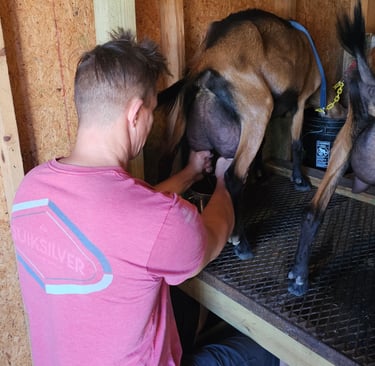
Milk Information
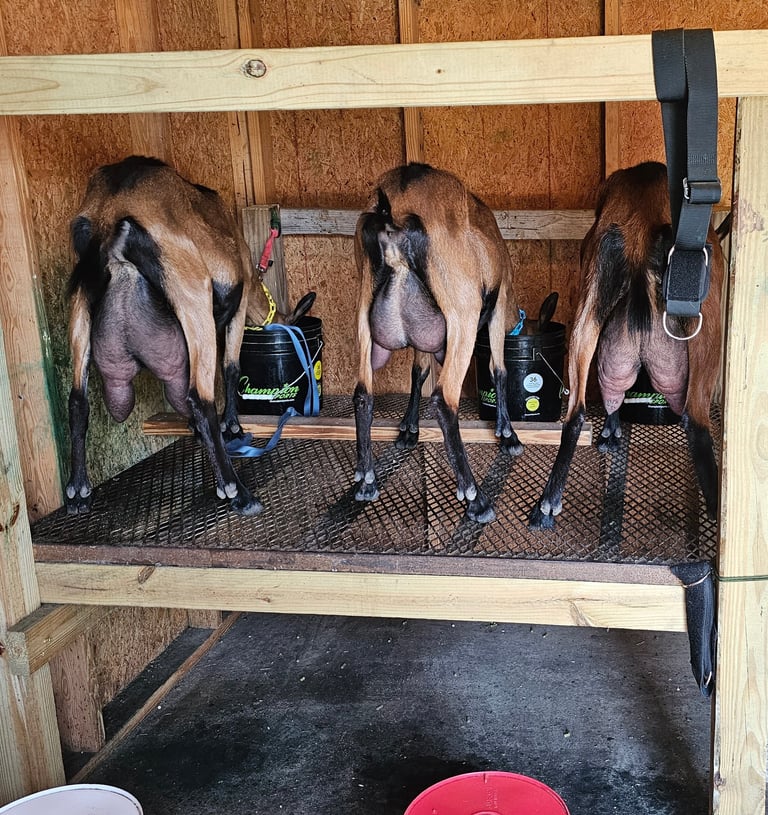


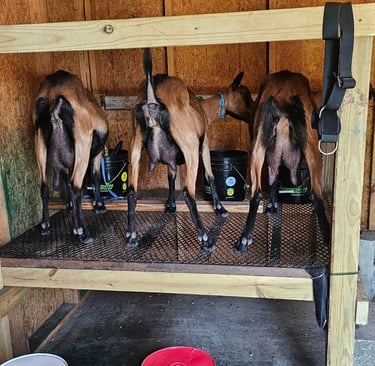
info@lokifarmsoutpost.com
© 2024. All rights reserved.
By appointment only
